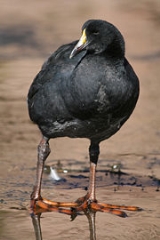
Giant Coot
Encyclopedia
The Giant Coot is a species of bird
found at lakes in the altiplano
from central Peru
, through western Bolivia
, to north-eastern Chile
and extreme north-western Argentina
. With a total length of 48–64 cm (19–25 in), it is the second largest extant member of the Rallidae
family, after the Takahe
, and adults are considered functionally flightless. It is the only coot
with reddish legs. An adult male weighed 2.7 kg (6 lb) while three adult females weighed 2.03–2.4 kg (4.5–5.3 lb).
As in the related Horned Coot
, the Giant Coot is monogamous and the pair builts a huge nest in a highland lake. However, unlike the Horned Coot, the nest of the Giant Coot is primarily made of aquatic vegetation and – as it is fiercely territorial
– it never forms colonies
.
Bird
Birds are feathered, winged, bipedal, endothermic , egg-laying, vertebrate animals. Around 10,000 living species and 188 families makes them the most speciose class of tetrapod vertebrates. They inhabit ecosystems across the globe, from the Arctic to the Antarctic. Extant birds range in size from...
found at lakes in the altiplano
Altiplano
The Altiplano , in west-central South America, where the Andes are at their widest, is the most extensive area of high plateau on Earth outside of Tibet...
from central Peru
Peru
Peru , officially the Republic of Peru , is a country in western South America. It is bordered on the north by Ecuador and Colombia, on the east by Brazil, on the southeast by Bolivia, on the south by Chile, and on the west by the Pacific Ocean....
, through western Bolivia
Bolivia
Bolivia officially known as Plurinational State of Bolivia , is a landlocked country in central South America. It is the poorest country in South America...
, to north-eastern Chile
Chile
Chile ,officially the Republic of Chile , is a country in South America occupying a long, narrow coastal strip between the Andes mountains to the east and the Pacific Ocean to the west. It borders Peru to the north, Bolivia to the northeast, Argentina to the east, and the Drake Passage in the far...
and extreme north-western Argentina
Argentina
Argentina , officially the Argentine Republic , is the second largest country in South America by land area, after Brazil. It is constituted as a federation of 23 provinces and an autonomous city, Buenos Aires...
. With a total length of 48–64 cm (19–25 in), it is the second largest extant member of the Rallidae
Rallidae
The rails, or Rallidae, are a large cosmopolitan family of small to medium-sized birds. The family exhibits considerable diversity and the family also includes the crakes, coots, and gallinules...
family, after the Takahe
Takahe
The Takahē or South Island Takahē, Porphyrio hochstetteri is a flightless bird indigenous to New Zealand and belonging to the rail family. It was thought to be extinct after the last four known specimens were taken in 1898...
, and adults are considered functionally flightless. It is the only coot
Coot
Coots are medium-sized water birds that are members of the rail family Rallidae. They constitute the genus Fulica. Coots have predominantly black plumage, and, unlike many of the rails, they are usually easy to see, often swimming in open water...
with reddish legs. An adult male weighed 2.7 kg (6 lb) while three adult females weighed 2.03–2.4 kg (4.5–5.3 lb).
As in the related Horned Coot
Horned Coot
The Horned Coot is a species of bird found at lakes in the altiplano of north-western Argentina, south-western Bolivia, and north-eastern Chile. It is almost entirely restricted to altitudes of 3000-5200 m.a.s.l., but has occasionally been recorded at lower altitudes...
, the Giant Coot is monogamous and the pair builts a huge nest in a highland lake. However, unlike the Horned Coot, the nest of the Giant Coot is primarily made of aquatic vegetation and – as it is fiercely territorial
Territory (animal)
In ethology the term territory refers to any sociographical area that an animal of a particular species consistently defends against conspecifics...
– it never forms colonies
Bird colony
A bird colony is a large congregation of individuals of one or more species of bird that nest or roost in close proximity at a particular location. Many kinds of birds are known to congregate in groups of varying size; a congregation of nesting birds is called a breeding colony...
.

